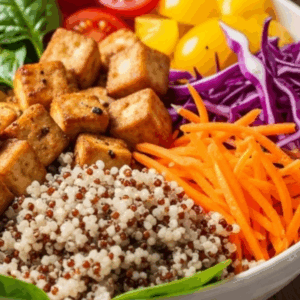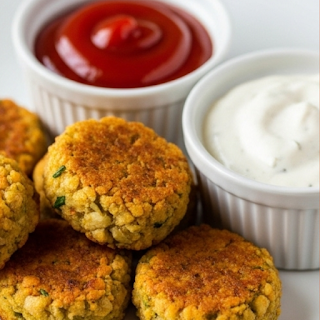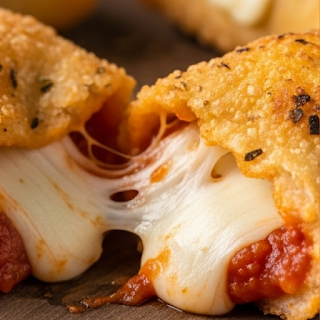Protein is often thought of in relation to meats, shakes, and heavy dishes—but high-protein salads show us that you can get the muscle-boosting power, satiety, and nutrition without sacrificing lightness or freshness. High-protein salads combine hearty sources of protein—like chicken, tuna, beans, eggs, tofu, or legumes—with crisp vegetables, fresh herbs, and flavorful dressings. The result is a meal that is filling, nutritious, and versatile.
These salads are ideal for anyone seeking to eat healthier: whether you’re trying to lose weight, build muscle, maintain your energy throughout the day, or simply eat more balanced meals. They give you satisfaction: the crunch, the texture, the bright taste of vegetables, plus the protein that keeps you full. They’re also great for meal prep—most ingredients stay fresh, and the salad can be assembled quickly, especially if the protein source is pre-cooked or canned.

Another advantage is flexibility. You can switch up the protein, vary the veggies, adjust the dressing, experiment with grains or seeds, or go vegetarian/vegan. High-protein salads can be tropical (with mango and shrimp), Mediterranean (with chickpeas, feta, olives), Asian (with tofu, edamame, sesame), or classic (chicken Caesar, tuna Niçoise). Everyone can find a version that fits their taste and dietary needs.
In the sections that follow, I’ll take you through the general benefits of high-protein salads, then dive into nutritional details of key ingredients, give you a clear ingredients table so you can pick or adapt your own high-protein salad with confidence.
General Benefits of High-Protein Salads
-
Increased Satiety
Protein is more satisfying than carbs or fats alone, meaning high-protein salads help you feel full longer, which can prevent overeating later in the day. -
Supports Muscle Health and Recovery
Especially for those who exercise, protein is essential for repairing muscle tissue. Salads with good protein sources can help recovery and maintain lean mass. -
Helps with Weight Management
Because they are filling and often lower in calories (when dressings and fats are managed), high-protein salads can support weight loss or maintenance. -
Balanced Nutrition
These salads often include fiber (from vegetables, legumes, whole grains), healthy fats (from oils, nuts, seeds, avocado), and micronutrients (vitamins and minerals) alongside protein. -
Versatility and Customization
You can mix and match ingredients based on what’s in season, what you like, or what your dietary preferences are (vegetarian, vegan, keto, gluten-free, etc.). -
Convenience & Meal Prep Friendly
Many ingredients can be cooked ahead or bought ready-to-use (e.g. canned beans, roasted chicken, tofu), and assembly is quick at meal time. -
Improved Metabolism and Energy Levels
Protein takes more energy to digest, helps maintain stable blood sugar, and combined with fiber, can contribute to more sustained energy. -
Appealing Taste and Texture
The contrast between crunchy veggies, soft proteins, creamy dressings, and maybe something crispy like seeds or nuts, makes each bite interesting.
Nutritional Benefits in Detail
Here are key ingredients often used in high-protein salads, and what they contribute to your health:
-
Chicken Breast / Turkey / Lean Meat: Excellent source of complete proteins (all essential amino acids), low in saturated fat if prepared well (grilled, baked), provides B vitamins and minerals like iron and zinc.
-
Legumes (Chickpeas, Lentils, Beans): Rich in both protein and fiber. They help improve digestion, stabilize blood sugar, and are good plant-based alternatives in vegetarian or vegan versions.
-
Eggs: Whole eggs (or egg whites for lower fat) provide high-quality protein along with choline (good for brain), vitamin D, and healthy fats.
-
Fish (Tuna, Salmon, etc.): Adds omega-3 fatty acids for heart health, plus complete proteins. Salmon also gives vitamin D, which many people are deficient in.
-
Tofu / Tempeh / Edamame: Soy-based proteins that are vegan, providing all essential amino acids, as well as calcium and isoflavones; edamame is also rich in fiber and iron.
-
Greek Yogurt / Cottage Cheese: Thick, creamy, high in protein with relatively low fat (depending on the kind), adds probiotics if yogurt is live, and calcium.
-
Nuts / Seeds (Almonds, Pumpkin Seeds, Chia, Hemp): Although more calorie-dense, they provide healthy fats, protein, fiber, plus micronutrients like magnesium, selenium, vitamin E. Good in moderate amounts.
-
Whole Grains (Quinoa, Farro, Brown Rice): Provide protein and fiber, slower carbs, supporting energy over time, and contain minerals like magnesium, phosphorus.
Ingredients Table
| Ingredient | Protein Content / Benefits | Suggested Amount / Notes |
|---|---|---|
| Chicken Breast (cooked) | ~ 25-30 g protein per 100 g | 100-150 g, cubed or shredded |
| Chickpeas / Lentils | ~ 8-9 g protein per ½ cup cooked | ½-1 cup, rinsed and drained |
| Hard-Boiled Egg | ~6 g protein each | 1-2 eggs, sliced or chopped |
| Greek Yogurt or Cottage Cheese | ~10-12 g protein per ½ cup | ½ cup as a topping or mixed in |
| Quinoa or Farro | ~4-6 g protein per ½ cup cooked | ½ cup cooked, cooled |
| Tofu / Tempeh / Edamame | ~8-15 g protein per 100 g | 100 g, pressed or cooked |
| Nuts & Seeds | ~5-7 g protein per 2 tbsp | Sprinkle lightly to avoid extra calories |
| Leafy Greens & Vegetables | Low protein but rich in fiber & micronutrients | 2-3 cups mixed greens |
| Healthy Fat (Avocado, Olive Oil) | Small amount of protein + healthy fats | ½ avocado or 1-2 tbsp oil |
| Flavor Enhancers (Herbs, Lemon, Spices) | Negligible protein but boost taste & nutrients | Use fresh or dried as desired |
Step-by-Step Preparation
-
Choose Your Base
-
Start with 2–3 cups of leafy greens: spinach, arugula, kale, or mixed lettuce.
-
Wash and dry well for a crisp texture.
-
-
Pick a Protein
-
Add 100–150 g of grilled chicken, turkey, tuna, salmon, tofu, or chickpeas.
-
For variety, combine two sources (e.g., beans + chicken).
-
-
Add Vegetables
-
Mix in colorful veggies such as bell peppers, cucumbers, tomatoes, carrots, or red cabbage.
-
Aim for at least 2–3 different colors for maximum nutrition.
-
-
Include Complex Carbs (Optional)
-
Add ½ cup of quinoa, farro, brown rice, or whole-grain pasta to make the salad more filling.
-
-
Boost with Healthy Fats
-
Top with ½ avocado, a drizzle of olive oil, or a sprinkle of seeds (chia, hemp, pumpkin).
-
-
Flavor with Herbs and Extras
-
Fresh herbs (parsley, cilantro, basil) add brightness.
-
Small amounts of feta, parmesan, or cottage cheese can boost protein and flavor.
-
-
Prepare the Dressing
-
Keep it light: mix olive oil, lemon juice, garlic, mustard, and a touch of honey.
-
For creaminess, use Greek yogurt as the base.
-
-
Assemble and Toss
-
Layer greens first, then protein, veggies, grains, and fats.
-
Drizzle dressing and toss gently before serving.
-
Variations and Creative Twists
-
Mediterranean Power Salad
Combine grilled chicken, chickpeas, cucumbers, tomatoes, feta cheese, olives, and a lemon-olive oil dressing. Packed with protein and healthy fats. -
Mexican-Style Protein Salad
Use black beans, corn, grilled chicken or shrimp, avocado, and cilantro. Top with a lime-yogurt dressing for a zesty flavor. -
Vegan Protein Bowl
Mix quinoa, edamame, tofu, kale, carrots, and sesame seeds with a tahini-lemon dressing. A fully plant-based option with complete protein. -
Classic Tuna & Egg Salad
Combine canned tuna, hard-boiled eggs, spinach, and red onion. Add Greek yogurt and mustard as a creamy high-protein dressing. -
Asian-Inspired Crunch Salad
Use shredded cabbage, carrots, grilled chicken, and edamame. Toss with sesame-soy dressing and sprinkle toasted peanuts for extra crunch. -
Warm Lentil & Salmon Salad
Pair cooked lentils with baked salmon, roasted cherry tomatoes, and arugula. Drizzle with balsamic vinaigrette for a hearty yet healthy salad. -
Breakfast-for-Lunch Salad
Combine spinach, hard-boiled eggs, turkey bacon, cottage cheese, and avocado. Add everything-bagel seasoning for a morning vibe. -
Meal Prep Mason Jars
Layer quinoa, beans, cucumbers, peppers, greens, and chicken in jars. Keep dressing at the bottom or in a separate container to stay fresh all week.
These variations show how versatile high-protein salads can be. You’ll never get bored, and you can adapt them based on your mood, ingredients on hand, or dietary preferences.
Serving Suggestions
-
Serve with whole-grain bread or pita for extra carbs.
-
Pair with a light soup for a balanced lunch.
-
Top with nuts or seeds for added crunch.
-
Add a boiled egg or grilled tofu cubes for an extra protein boost.
-
Use as a meal prep staple—store in airtight containers and keep dressing separate until ready to eat.
Conclusion
High-protein salads prove that healthy eating doesn’t have to be boring. With lean proteins, fresh vegetables, hearty grains, and flavorful dressings, these salads are satisfying enough for a full meal while still being light and refreshing. They offer the best of both worlds: nourishment for your body and delicious flavors for your taste buds.
They’re also incredibly versatile. Whether you’re following a vegetarian, vegan, low-carb, or high-protein diet, you can adapt the salad to your needs. From Mediterranean to Asian flavors, from meaty to plant-based, there’s a high-protein salad for everyone.
Perfect for busy lifestyles, these salads are quick to prepare, great for meal prep, and easy to pack for work or school. They’re proof that with a little planning, you can enjoy meals that are healthy, filling, and exciting.
So next time you’re hungry for something nutritious, skip the boring lettuce bowl and make yourself a vibrant, high-protein salad that will keep you energized and satisfied throughout the day.



